How to Start a Trucking Company: A 14-Step Guide
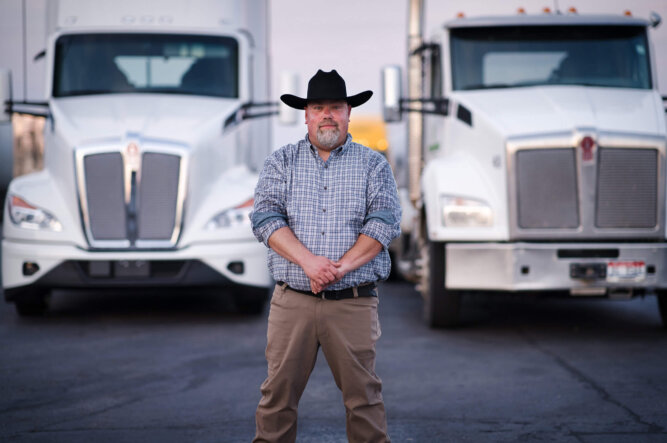
There's a better way to find loads.
Demo the Truckstop Load Board and see how easy it is to find the right loads fast.
Find your next load
Make more money starting now.
Truck drivers are the lifeblood of our nation, delivering a whopping 70% of all goods across the U.S worth an estimated $700 billion. This opens up opportunities for people who want to start a trucking business in this high-demand industry, either as a fleet owner or owner-operator.
The trucking industry is hard work but can offer big rewards with steady pay. This comprehensive guide has everything you need to get rolling. Whether you’re a seasoned trucker ready to build a team, boost your income, and secure your future, or a fleet driver seeking independence, this roadmap will guide you toward success in the trucking industry.
Step #1: Create a business plan.
A solid business plan is an essential step in starting a new business. The Small Business Association (SBA) recommends your business plan should project 3-5 years ahead and include how you plan to grow revenue.
A business plan typically includes:
- Executive Summary. A brief description of you, your company, and how you plan to achieve your goals.
- Company Description. More detail on you and your business, what sets you apart from other trucking companies, and how your trucking industry knowledge and experience will benefit your company.
- Operations. The technology, systems, and staffing you plan to deploy to operate efficiently.
- Services. A list of the services you will offer customers.
- Market Analysis. An analysis of the current marketplace and how your company will be able to generate revenue.
- Sales and Marketing. How you will attract and build a loyal base of customers.
- Financial Projections. A roadmap that explains how you will accomplish your revenue goals.
If you’re asking for financing or soliciting investors, you will also want to include a funding request.
Learn more with our detailed guide: How to Create a Trucking Business Plan
Step #2: Get your commercial driver’s license.
Whether you’re an owner-operator or you hire drivers, you/they need a valid commercial driver’s license (CDL), as required by the Federal Motor Carrier Safety Administration (FMCSA).
To become a trucker, you’ll need to pass a CDL application process. This includes submitting documents (ID, residency, SSN), vision tests, and knowledge exams. After receiving a commercial learner’s permit (CLP), you’ll demonstrate your skills with a pre-trip inspection and road test with your vehicle. You can apply if you’re over 18, but you must be at least 21 to drive interstate. After passing these tests, drivers pay the applicable fees and receive their CDL.
Step #3: Apply for your trucking authority.
One of the first steps in exploring how to start a trucking business is to complete your trucking authority. Trucking businesses need to have an operating authority when they work as a hire carrier over state lines for vehicles with more than 10,000 gross vehicle weight (GVW).
There are a few key steps to get your trucking business licensed and ready to roll. First, secure a unique business name by checking availability and registering it with your state. Then, head to the Federal Motor Carrier Safety Administration (FMCSA) to apply for trucking authority. This process involves obtaining your Motor Carrier number (MC#), which is essential if you plan on transporting goods across state lines. With these licenses in place, you’ll be well on your way.
Step #4: Select process agents.
Every state you operate in requires a process agent. This designated person accepts legal documents on your behalf, fulfilling an FMCSA requirement. Your business needs process agents in every state in which you travel, work, and operateDon’t skip this crucial step – it ensures you’re properly notified of any legal matters concerning your business.
Process agents are helpful because they work on your behalf if you ever have a problem in another state. As noted in Step #2, your process agent completes your BOC-3 paperwork. To find available process agents, refer to the FMCSA’s site.
Step #5: Determine your business type.
When you want to start a trucking company, you will have to file taxes with the IRS. Be sure to choose a business structure for your trucking company. This could be a sole proprietorship, partnership, LLC, or corporation, each with its own tax implications. Consult a tax accountant to find the structure that best suits your needs and helps you navigate future tax filings.
Some business owners file sole proprietorship, which is the cheapest and easiest when filing taxes. But if a person or business sues you as an owner or owner-operator, they can sue you personally. If you have a corporation, they would sue your company, which protects your personal assets.
Step #6: Open a business bank account.
Establishing a dedicated small business bank account and a business credit card is a smart move. This keeps your personal finances separate for tax purposes and helps build a strong business credit score. This score is vital for securing future loans and funding you might need to grow your trucking company. The good news? You can start building credit right away. Use your business account to pay for essential things like licenses, permits, and insurance.
Step #7: Know the legal requirements.
The trucking/transportation industry is a highly regulated industry. That means the FMCSA has several legal requirements for owner-operators.
- Apply for your U.S. Department of Transportation (DOT) number and your Federal Authority.
- File a BOC-3 and start a trucking insurance policy (primary liability, cargo).
- Get your International Fuel Tax Agreement stickers.
- Register for your UCR permit and International Registration Plan (IRP) and get apportioned plates.
- Obtain an Employer Identification Number (EIN) from the IRS, whether you’re filing as a sole proprietor, LLC, or corporation, to establish yourself as a business entity.
- Install FMCSA-compliant electronic logging devices in your vehicles (for non-exempt carriers).
- Obtain a Standard Carrier Alpha Code (SCAC) from the National Motor Freight Traffic Association (NMFTA).
- If your truck weighs more than 55,000 pounds, you are required to pay heavy highway vehicle use taxes using IRS tax form 2290.
- Get the required business licenses from your state and/or city.
Step #8: Get insured.
In 2022, large trucks accounted for 120,200 injury crashes and 5,837 fatal crashes. Transportation businesses need insurance to protect against losses, including damages and injuries caused by commercial vehicles. Shop around for the best rates and refer to the FMCSA insurance filing requirements.
Trucking insurance might include:
- Commercial liability insurance: $750,000 in coverage. Some brokers require $1 million in coverage.
- Cargo insurance: $100,000 in coverage.
- Physical damage: This coverage protects you in no-fault accidents.
- Non-trucking use: This covers accidents if you’re hauling loads for another person or company.
Find additional information with the Owner-Operator Independent Drivers Association.
Step #9: Get financing.
When you start as a trucking business owner, you may need to get business loans or find investors to pay for startup costs. If you do apply for a business loan or seek investors, make sure you have completed all of the steps above.
Check with large and small banks and credit unions for financing. Credit unions can be easier to get a loan from, as larger banks want to see two years of operating history. You can also check online for trucking lenders.
If you need to approach lenders, investors, or partners to finance your trucking business, the first thing many of them will want to see is your business plan.
Step #10: Get a truck and/or trailer.
Commercial truck financing terms vary depending on your credit. When you purchase your truck(s), there are different types of leasing options available.
Types of leases:
- Operators: You own or lease the vehicle full-time and always have it in your possession. You pay for permits, taxes, and maintenance and turn it in when the lease ends.
- Lease Purchase: Lease-Purchase is for drivers with less-than-perfect credit. They can finance trucks right away but may pay more in interest.
Terminal Rental Adjustment Clause: You pay a down payment up front, and at the lease end you can pay the balance for the vehicle. Or, let the leasing company sell the vehicle, and they might share part of the profit with you.
Step #11: Subscribe to a load board.
Subscribing to a load board is the best way to keep your trucks full and on the road. They help connect you with shippers, brokers, and find loads.
The Truckstop Load Board features include:
Load Searching

Load searching gives you unlimited access to jobs in every state where you work. Access rates, load weights, and distances all in one glance. Use the Book It Now feature, and in a few clicks, view new available loads and click on the ones you want to book.
Unlimited Lane and Truck Postings
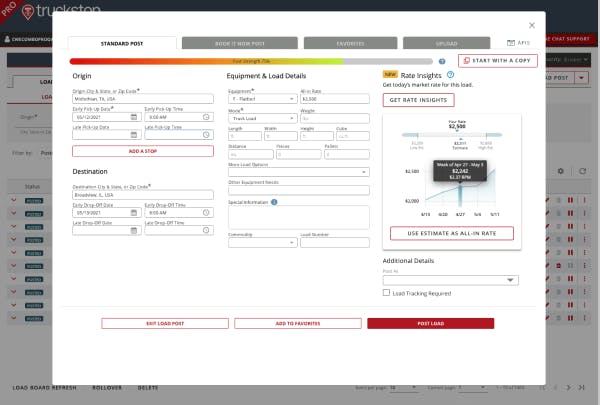
View accurate routing and mileage data anywhere you drive. Know the distance to your next pick-ups and calculate fuel consumption. You can also view postings by load, truck, or lane. Use custom features for weight, height, quantity, and vehicle type.
Decision Tools

Use Rate Insights and Decision Tools to help you negotiate better with brokers (potential business partners). Find out key criteria like how many other truckers are viewing jobs, lane rates, and backhaul options.
Book It Now
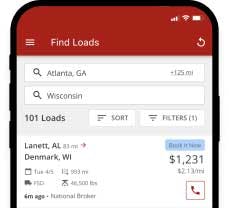
This option lets you instantly book on any device (phone, tablet, laptop). Use the refresh feature to update for recent job postings in real time. Sort by the age of the listing or other categories. You can view the available rates and all load information up front before you book it.
Fuel Desk
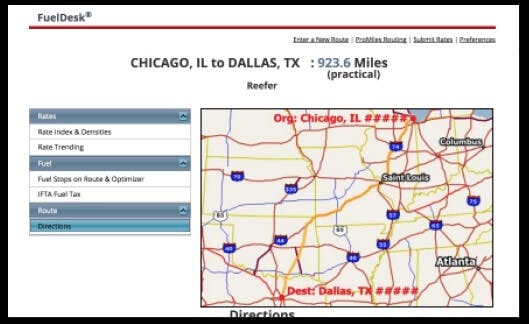
View the IFTA data and all available rates and routes. Quickly calculate fuel costs and find nearby fuel stops. Find alternate routes and rate criteria in a few simple clicks.
Credit Stop Broker
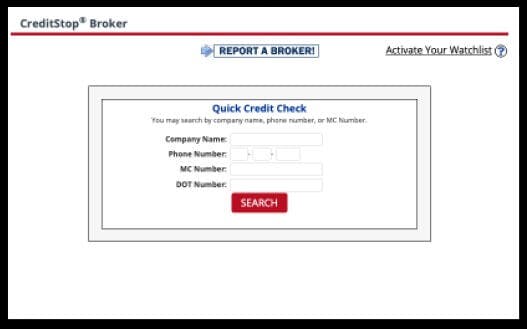
Run credit checks on a broker before accepting offers. Find reviews by searching for their company name or DOT number. Set up convenient watchlists to match brokers with drivers.
Flexible Payment Plans
Starting with just a few drivers? Want to find the best rates fast? Choose from convenient plans that help you grow your business over time. Upgrade features as your company grows or you expand your services.
Step #12: Create a system for managing finances.
Steady cash flow will be necessary as you get your business moving. This includes payments for equipment, supplies, labor, fuel, and utilities. New trucks often cost between $100,000-$200,000, and you’ll have other expenses with your own trucking company, like insurance, legal fees, and maintenance.
Consider streamlining your accounting from the start. You can either tackle this yourself using user-friendly accounting software like Intuit QuickBooks, or outsource it entirely. If you choose to outsource, wait until you have secured financing to bring on the best bookkeeper you can afford. Having a skilled bookkeeper from the beginning will ensure your finances are meticulously organized, and partnering with a top tax attorney can provide invaluable guidance as your business grows.
You may want to consider invoice factoring to get paid more quickly and reduce administrative paperwork, such as billing and collections. Freight factoring provides quick cash for your invoices by outsourcing the collections process to a third-party factoring company company. They purchase your invoices at a slightly reduced rate, eliminating the need for you to chase payments or use your savings while waiting for payments.
Step #13: Hire staff.
If you plan to run your company as more than an owner-operator venture, you will need to hire employees to support your company. Depending on your size and revenue goals, you might need to consider adding staff such as:
- Drivers
- Accounting or payroll managers
- Sales and marketing personnel
- Logistics coordinators
- Dispatchers
- Receptionist or administrative staff
Some trucking companies choose to outsource some of the admin, accounting, sales, and marketing strategies or wait to add staff until the volume of work requires an in-house team.
Step #14: Monitor compliance.
When you own a business, it’s your responsibility to maintain compliance with applicable laws and regulations. This means filing quarterly tax returns, maintaining renewals for CDLs, and staying aware of state requirements and national trucking industry regulations. Additionally, brokers want to hire and work with carriers who have their regulations up to date to reduce liability. Monitoring compliance and staying up to date on regulations will be key to winning business as a truck driver.
Besides all of the items listed under the legal requirements section, you also need to ensure your company operates within the legal requirements for:
- Hours of service (HOS) regulations
- OSHA safety regulations
- Inspection, repair, and maintenance logs
Ready to get started?
When you start a successful trucking business, it can be a great way to make a living. As a new operator, however, it can take time. Don’t let the initial paperwork or credit requirements stop you from owning your own business.
With driver and truck shortages, more owner-operators are finding financing and leasing options despite a less-than-perfect credit record. As more people shop online and want items delivered, the trucking industry will be in high demand — and that creates opportunities for you to make more money.
Once you set up your company, get insurance, and hire drivers, use the Truckstop Load Board to find loads, stay loaded and make extra income.
FAQs
Topics:

Find out how our platform gives you the visibility you need to get more done.
Get helpful content delivered to your inbox.
Schedule a demo.
Find out how our platform gives you the visibility you need to get more done.





